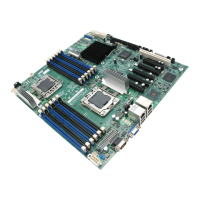VMware vSphere* 4.1 Installation Guide for ESX*
25
VMware ESX* 4.1 Installation
Install ESX* 4.1 to get started with running virtual machines. The machine running ESX virtualization
software will act as a host in the virtual infrastructure. Hosts provide CPU and memory resources, access to
storage, and network connectivity for virtual machines that reside on them.
Install ESX* 4.1
Use the ESX* 4.1 CD to install the ESX 4.1 software onto a SAS, SATA, or SCSI hard drive. Installing on a
Fibre Channel SAN is supported experimentally. Verify the server hardware clock is set to UTC. This setting is
in the system BIOS.
Verify a keyboard and monitor are attached to the server the ESX* software will be installed on.
A USB or installed CD is needed to load the software.
To install ESX* 4.1, perform these steps:
1) Ensure that the DVD is plugged into Server1 with the latest ESX* 4.1 software.
2) Power-on Server 1.
3) Enter the BIOS by pressing the F2 key.
4) Select the Boot Manager tab.
5) Select the USB DVD or DVD drive to boot off the DVD and Install ESX* 4.1.
6) After the ESX* 4.1 screen displays, select “Install ESX in graphical mode”.
7) A series of installation messages display until the Welcome page appears. Click “Next” to continue.
8) Select “I accept the terms of the license agreement”, then click “Next”. Installation cannot complete
unless the license agreement is accepted.
9) Select the keyboard type from the list, then click “Next”.
10) Select whether to install custom drivers with the ESX* installation. Select “Yes” to load system drivers;
custom drivers do not have to be installed. Custom drivers can be installed after the ESX installation is
complete, using other command-line and GUI tools, such as the vSphere* CLI and vCenter Update
Manager*. Click “Next” to continue.
11) A pop up message appears. Click “Yes” to load the required ESX* drivers.
12) Click “Next” when the drivers finish loading.
13) Configure ESX* licensing:
a) Select “Enter a serial number now”, enter the vSphere* license key, then click “Next”.
b) If a license key is not available during the installation, select “Enter a license key later”, click “Next”.
This choice allows ESX* evaluation (or enter a vSphere* license key later using the vSphere Client).
14) Select the network adapter for the ESX* service console. Virtual machine network traffic shares this
network adapter until a virtual switch is configured for another network adapter. Other network
adapters can be configured at a later time from the vSphere* Client.
15) If the adapter is connected to a VLAN, select “This adapter requires a VLAN ID”, enter a VLAN ID number
between 0 and 4095, then click “Next”. VLAN ID for VMs is described later in the recipe.
16) Configure the network settings:
a) VMware* recommends using a static IP address to simplify client access. To use static settings but
the required information is not available, use DHCP for the installation and configure static settings
after consulting with a network administrator.

